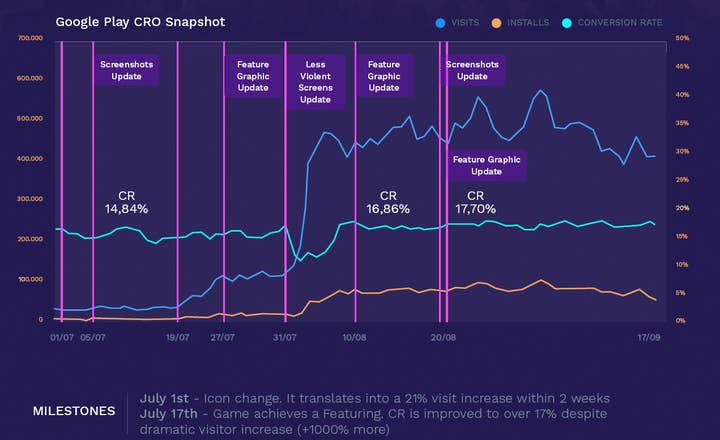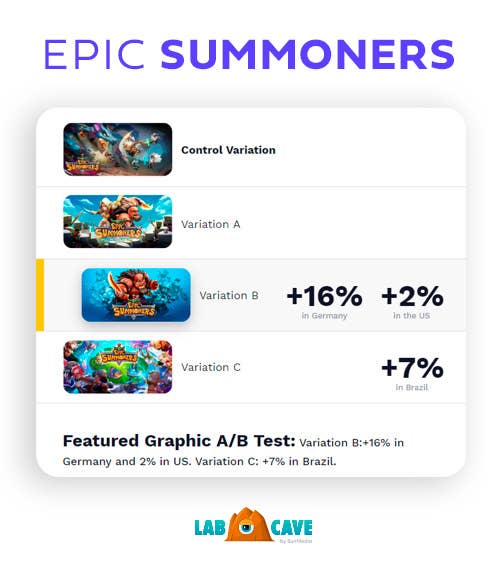The secrets to standing out on mobile app stores
Sponsored article: Lab Cave's Virginia H. Plaza explains how to make your app shine on the iOS App Store and Google Play
The biggest challenge for anyone publishing a mobile app is grabbing users' attention, obtaining installs and keeping those install figures growing over time. Whether you're publishing to Apple's App Store or the Google Play store, it's challenging for the sheer number of competitors you'll face with similar apps and branding.
At Lab Cave, we work with mobile app developers and publishers every day. I began working in the mobile world just as the concept of App Store Optimization (ASO) was emerging. It's grown to become a complex topic that's changing all the time as storefronts evolve and store algorithms are revised.
At Lab Cave, we've spent almost seven years building data and research into how both major app stores are used by platform holders and by users, and there are some fundamentals of ASO every mobile app developer should understand to give their titles the best possible chance of success.
Traffic jam
There are fundamentals of ASO mobile developers should understand to give their titles the best chance of success
Traffic will come to your app store pages either organically or because you spent money. We often speak of paid traffic as 'user acquisition,' and by definition you'll only receive that kind of traffic by spending money on advertising, sponsorships, influencer campaigns and other activities.
Organic traffic comes to your store page through two different routes: 'Search' and 'Browse' (or 'Explore' on the Google Play store). App Store Optimization relies upon your own ingenuity and knowledge. It's about using language, creatives and other methods to increase your search ranking and boost your chance to be found through Browse or Explore channels.
Searching for your app
Mobile users browse stores very differently depending on what they're searching for. If your title is a major brand, you'll find much of your traffic is driven by searches for your app's branded keywords.
A recent major app we studied received 97% of its traffic from Search for the brand and only 3% from their descriptive keywords. Branded keywords are protected, and a brand like 'FIFA' is safe from needing to run campaigns to retain ownership over their strong keywords. Branded words are important but not available to most developers, so for most a new title will need a robust organic keyword strategy to drive Search traffic.
Positioning the most relevant and appealing keywords relating to your app is your first step for organic search traffic acquisition. Being ranked highly for your chosen keywords means greater visibility in Search results and better chance of placement in Browse channels.
Begin by describing your app with five words. Those are your main keywords
Begin by describing your app with five words. Those are your main keywords. From there, it's time to research your competition. When you search for your chosen terms, what results do you receive? What titles top the search results? How do your competitors fare with the same searches, and how do the category's leaders describe themselves?
Subtle changes can make major differences. Is your app a 'driving game' or a 'racing game' or a 'car game'? Which keywords will you focus on to position your app properly?
Think about both short-tail and long-tail keywords. Someone searching for a horse racing title will quickly realize a search for 'horse' gets them a mix of racing, grooming and general interest apps, but 'horse racing game' gets them more appropriate results.
Long-tail keywords ('first person shooter') will bring less traffic than more generic short-tail ones ('shooter'), but we've learned the more specific a search term is, the more likely the user will be to install the app. Competition for very specific search terms is lower, so if you're making a first-person open-world horse grooming game, you should be sure anyone making that very unique search can find you!
Once you've chosen keywords in your own language, you can begin thinking about localization. With a global marketplace you're probably already thinking about translating your app and store description into multiple languages. However, only 25% of internet users speak English, which means you could lose out on up to 75% of your potential users without good localization!
But remember that translation isn't localization. Popular search terms vary from nation to nation
But remember that translation isn't localization. Popular search terms vary from nation to nation and different nations can use different terms while speaking the same language. In English-speaking countries gamers might consistently search for 'car' when looking for a racing game. That same search for 'car' becomes 'carro' in Latin America, but here in Madrid we would say 'coche.' Understanding the most popular keywords in territories you're launching your app is essential and can be difficult to monitor from afar. Even if you speak the language, seek out local knowledge.
If you're distributing your app on the Google Play store, Google's Developer Console gives you insights on the most popular search terms coming from search traffic around the world. The keywords you'll find here will let you see how people are currently finding your app.
Unfortunately Apple offers no equivalent for iOS. Be careful with assumptions made from Google Play's results -- in our experience, iOS and Android users don't always search and behave the same way, but in the absence of other datapoints the Developer Console on the Google Play store is a good place to begin optimization.
Browsing for your app
Many users browse an app store without a particular agenda. Charts, categories, featured apps and similar app recommendations are all important, and appearing there is often dependent on improving the frequency of your installs by increasing your organic traffic via other means, whether through User Acquisition, influencer campaigns or media coverage.
Other avenues are available through different storefronts. Apple runs a curated frontpage with selections and recommendations from a local editorial team. You can apply to have your app featured there, or Apple's own algorithms might highlight your wildly successful app! Typically you'll need a very high-quality title to see it featured there, but you've got that covered, right?
An uplift in organic traffic means you are going to increase your position in the rankings, which will improve your potential for receiving a featuring in the store, assuming a store editor likes your app.

Looking the part
The goal of an optimized product page featuring relevant keywords and appealing graphic elements is to convert choosy visitors to beautiful installs. Your icon, screenshots, video and feature graphic will need to be relevant and attractive.
Larger companies and bigger brands generally play safe with established iconography and the trends of the category, but smaller companies aren't held to the same rules. Straying from the established conventions can be beneficial.
The theme for Conversion Rate Optimization (CRO) is to try new approaches regularly. Look for patterns, then break them by trying something different to see how it affects your app. Constant experimentation reduces your risks. Keep benchmarking your app against other titles in the same category. How does your store page compare? Are users able to find alternatives to suit their needs? Do your chosen keywords still bring people to your page?
This process is made easier on Google's Developer Console where it is simple to run A/B tests and identify what kinds of visuals work for your app. Make regular, frequent tweaks to your presentation and carefully monitor download numbers to achieve the results you're aiming for. Try to identify the changes that turn page visits into app installs.

Beyond the fundamentals
The fundamentals of ASO I've talked about are consistent and achievable for developers and publishers at every level. Search is where optimization begins but the perfect strategy involves optimizing all your possible traffic channels and regularly reviewing your pages to stay competitive and relevant.
If you have your app optimized to get the most out of search but don't have a great creative approach or a solid UA strategy then you're going to miss opportunities.
App stores are ever-changing. With every store update we observe changes to the store algorithms and adjust our tactics. Because Lab Cave has a library of our own self-published apps we can quickly run tests and analyze trends. It gives us a major advantage as we're able to experiment with our own products to gather data and react accordingly.
This is knowledge we've learned over many years. Lab Cave has published hundreds of games and with each launch we've learned new information about both stores. Today Lab Cave is home to masses of data, powerful tools and a large team who have a deep understanding of mobile app publishing. Above all, we have our experience to guide us.
I want to encourage developers and publishers to build that experience for themselves, and to speak with us if you think we can help. We want the mobile business to grow for everyone.
Virginia H. Plaza is a business analyst specialising in ASO and CRO at Lab Cave by SunMedia, which has recently launched its 360 mobile growth platform focused on ASO, user acquisition, mediation, monetization and mobile publishing. Contact Lab Cave at hola@labcavegames.com